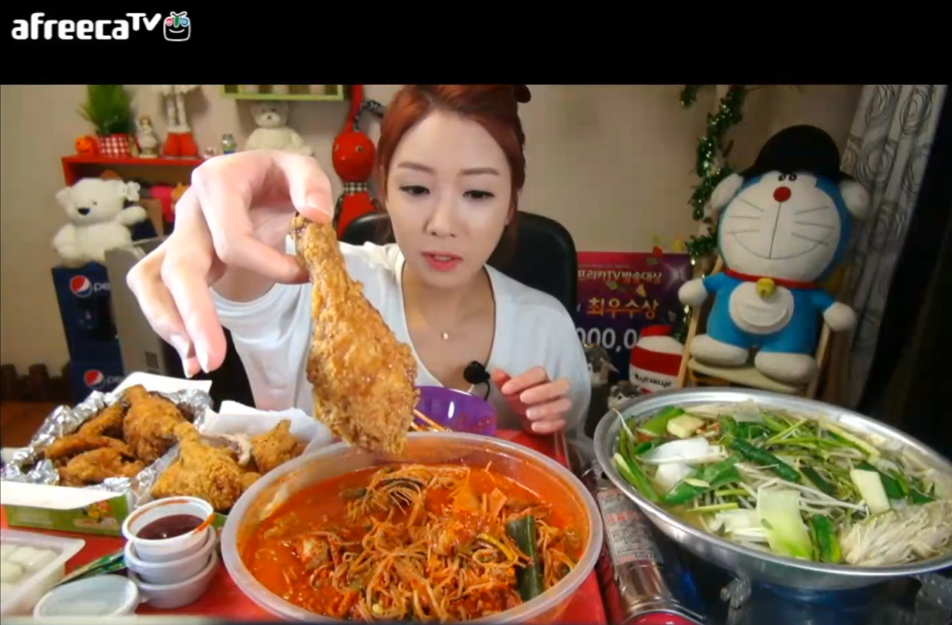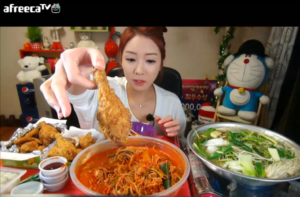The word ‘mukbang’ itself is made up of two words—”Muok-da”, which means “eating”, and “bang-song”, which means “broadcast”—it’s pretty self-explanatory. Chances are that you know mukbang as the niche trend where people munch away at obscene amounts of food in one sitting. Sometimes there’s ASMR involved; other times it’s a full blown temper tantrum (let’s not talk about Nikocado Avocado just yet).
However, contrary to popular belief, mukbang is not new, and its origins are vastly different from the widespread binge-fest that it has become on YouTube. It began sometime in 2008, and it has been popular in South Korea for the last decade. But it only gained global traction in 2015.
The History of Mukbang


The real beginnings of mukbang are actually really… wholesome. In South Korea (and in Asia generally, really) mealtimes are inherently very social. Food is such a huge part of Asian culture, so eating together is a great way to bond and connect with friends and family. Humans, after all, are social creatures, and despite the inconvenience in our fast-paced world, many of us still prefer a sit-down dinner with flowing conversation to a solitary meal.
However, Korean society as a whole has been gradually moving towards a more individualistic household culture. More people are living alone and working immense hours, which means that more people are eating alone too. The once sacred social mealtime has become less and less commonplace in our modern world.
In fact, Serim An, an Afreeca TV public relations coordinator said: “We think it’s because of three big reasons—the rise of one-person households in Korea, their ensuing loneliness and finally the huge trend of ‘well-being culture‘ and excessive dieting in Korean society right now.”


This was all happening in 2008, and continued on well into the next decade. So, in search of comfort and company, people began turning to the internet (as you do) and mukbang was born. Initially limited to streaming platforms such as AfreecaTV, mukbangs were livestreams—a simple way to connect and hang out with other people in real time, and maybe curb the loneliness for a few hours.
The general idea is that the mukbanger would cook (or order in) and eat on camera while viewers would leave comments, chat and interact with the hosts. In other words, watching it would be like sitting down for virtual dinner with your pal.


After mukbang gained more popularity online, the broadcasting aspect became more performative. It was now all about viewer experience, and thus the first iteration of the ultra-sensory, expression-filled mukbang was born. It’s explained pretty well in this video: BJs (broadcasting jockeys) would create specific ‘sounds’ to express their delight, and the excessive slurping, smacking and chewing is all for the benefit of the viewer.
You may ask—how? Well, the idea behind the exaggerated reactions is to include the viewer in the food experience. Think of it as a way to effectively communicate how the food tastes through a screen. It’s a little eclectic to watch, and it certainly isn’t everyone’s cup of tea, but the attractive prospect of ‘belonging’ makes sense.
Plus, OG mukbang doesn’t necessarily constitute a gross-out binge-fest—one important thing to note from MC Yusin in that video is that he doesn’t overeat. He has a set amount of food that he finishes in a set amount of time, and then that’s it; he signs off. So, where did the binge aspect come from?
All the way to the West


Every trend eventually makes its way to America (though it often takes a couple of years). Enter: “The Mukbang Craze” of the West. What started as a sensory experience that allowed you to connect with others soon became a bingeing contest when America added a ‘food challenge’ element to the concept. Now, it’s just about how much food you can scoff down in one sitting.
Scrolling through YouTube, all you’ll find are clickbait thumbnails featuring gross amounts of food and a plethora of people eating themselves sick. However, that’s not where the differences end: The main difference between American mukbang and the OG Korean mukbang is the fact that it’s now all pre-recorded. Lost is the feeling of connection, intimacy, and belonging, and in its place is something else.
It has also affected the structure of the content itself. Originally, the commentary of Korean hosts was focused on interacting with their viewers. Other than that, they were largely silent so as not to draw attention away from the food.
In contrast, the Western approach to mukbang commentary is very much a “Let’s get to know me” session. Hosts will talk about themselves while scoffing things down; after all, the audience isn’t there until after the video is published, so they have to entertain them somehow, right?
But how did it get to the West in the first place? Well, you can thank The Fine Brothers and their “React” series for that. The story goes that their 10 minute YouTubers React video is the thing that put the genre on the radar of America’s general population. It makes sense, too—the video, as of now, has amassed 6.7 million views.
Negative Feedback


At this point, you’re probably thinking: Americans aren’t the only ones doing binge-mukbang, though. Well, you’d be correct: They’re not. The trend has gone well and truly global, with hosts from every continent developing a taste for the genre. Keep in mind, though, that what it has evolved into is starkly different from where it came from.
Of course Korean, Japanese and Chinese influencers have picked up the trend where America has left off. They’ve moved from livestreaming to YouTube too—and that’s where we are today. The genre has become a competition, not only to see who can binge the most, but who can bring the biggest shock factor.
As influencers continue to attempt to outdo each other, the videos are getting more and more outrageous. We mentioned Nikocado Avocado and his drama—his entire brand is basically having a mental breakdown on camera while he gorges on obscene amounts of grub.
(Writer’s note: While researching this article, I had to subject myself to hours of his content—my YouTube recommendations still haven’t recovered)
Sso Young, on the other hand, has built her career by torturing animals before she eats them alive, all while projecting a cutesy ‘little girl’ persona—no joke, there’s literally a petition against her. In fact, many people have called her out on it, including one of YouTube’s most prolific commentary and gaming channels (linked below), yet she somehow continues to garner more and more support for her content.
In short, it’s become exhausting. That said, not all mukbang is like this, and there is definitely content out there that stays true to the original values. For example, instead of going straight for shock value, mukbangers like YAMMoo have opted to tap into the ASMR market.
What we’re saying is that if it’s your thing, the genre isn’t wholly bad. There are definitely videos and streamers out there that cater to those of you who just want to sit back and enjoy yourselves. It’s just difficult to find them over all the noise.
Find more culture stories like this here.
| SHARE THE STORY | |
| Explore More |




